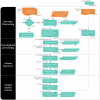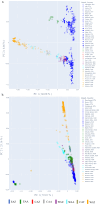Genomic Reference Resource for African Cattle: Genome Sequences and High-Density Array Variants
- PMID: 39030190
- PMCID: PMC11271538
- DOI: 10.1038/s41597-024-03589-2
Genomic Reference Resource for African Cattle: Genome Sequences and High-Density Array Variants
Abstract
The diversity in genome resources is fundamental to designing genomic strategies for local breed improvement and utilisation. These resources also support gene discovery and enhance our understanding of the mechanisms of resilience with applications beyond local breeds. Here, we report the genome sequences of 555 cattle (208 of which comprise new data) and high-density (HD) array genotyping of 1,082 samples (537 new samples) from indigenous African cattle populations. The new sequences have an average genome coverage of ~30X, three times higher than the average (~10X) of the over 300 sequences already in the public domain. Following variant quality checks, we identified approximately 32.3 million sequence variants and 661,943 HD autosomal variants mapped to the Bos taurus reference genome (ARS-UCD1.2). The new datasets were generated as part of the Centre for Tropical Livestock Genetics and Health (CTLGH) Genomic Reference Resource for African Cattle (GRRFAC) initiative, which aspires to facilitate the generation of this livestock resource and hopes for its utilisation for complete indigenous breed characterisation and sustainable global livestock improvement.
© 2024. The Author(s).
Conflict of interest statement
The authors declare no competing interests.
Figures






References
MeSH terms
LinkOut - more resources
Full Text Sources

